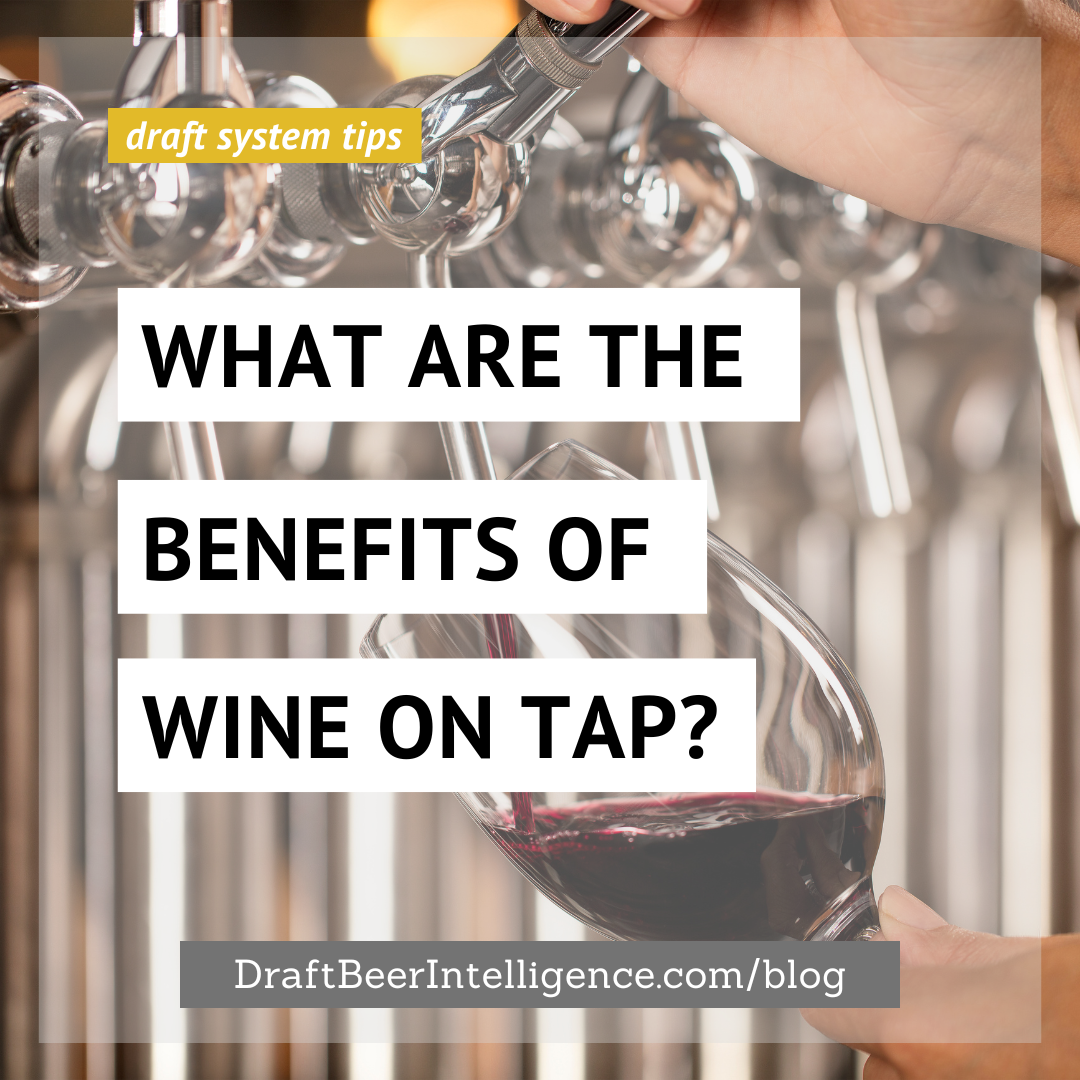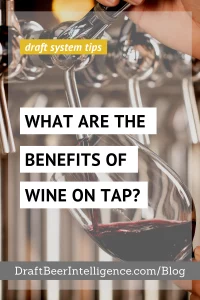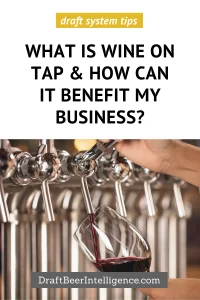Why wine on tap? Business owners understand the importance of cutting costs, so wine on tap has become a go-to choice for many establishments. With high quality and significant savings, it’s no surprise that this modern innovation in serving wine has gained widespread traction over recent years!
As restaurants and bars adopt Wine on Tap programs, they are shocked when they realize the annual cost savings of dispensing wine through a draft system while still providing customers with delicious, higher-quality premium wine. Not only that, but with an ever-growing assortment of varietals available in kegs, you’ll find a unique flavor profile everyone will love!
Let’s discuss the benefits of wine on tap and how your business could benefit from making the switch.
What Is Draft Wine?
The “Draft Wine” or “Wine on Tap” revolution was pioneered by Free Flow Wines out of Sonoma, CA. They are the innovator of premium draft wine. Their commitment to sustainable operations through their keg leasing and logistics services has changed how quality wines are served. There is no more worrying about stale bottles or excess wastage! Free Flow is determined to deliver an unforgettable experience with every glass.
As an industry leader, they strive towards continuous improvement and work hard to find new innovative ways that break away from traditional ‘bottle’ service methods – giving wine enthusiasts fresh flavors.
Wine on Tap is a wine filled into stainless steel kegs and then served from a wine tap system instead of wine bottles, similar to how draft beer is served. When you’re ready to pour wine, tap the keg into your dispensing system, which is almost identical to a draft beer system. Once the wine kegs are delivered, you store them in a cool environment (like you would bottle wine).
Wine on tap is trending because it offers many benefits over traditional bottled wine. These benefits include time savings, reduced waste, increased profits, and better quality. Let’s dive deeper into each of these…
Why Switch To Wine On Tap?
🍷PROFITABILITY
Wine on tap is more profitable than bottled wine for several reasons. First, there’s no need to invest in costly wine bottle storage racks and dual-temperature wine chillers. Second, you’ll save on labor costs because it’s quicker and easier to pour wine from a keg than to open and serve bottles of wine.
Finally, you won’t have to worry about wine wastage. Wine on tap is a growing trend that is popular among consumers. Once tapped, each wine keg is good for up to three months—bottled wine, once opened, starts to deteriorate once it sees oxygen. A wine keg is equivalent to 26 bottles of wine. As a result, investing in a wine-on-tap system is an intelligent way to boost your bottom line.
🍷QUALITY/TASTE
Wine lovers rejoice! Wine on tap is an excellent way to serve high-quality wine without breaking the bank. When you pour wine from a bottle, you can lose up to 25% of the content to oxidation. Wine on tap is guaranteed to be a fresh, great-tasting glass of wine. No oxidation, no light. The perfect pour every time, just like the winemaker intended.
A wine’s taste comes down to two things – good quality wine and keeping the wine fresh. Wine on tap does both of these things effortlessly.
Some wine drinkers assume that draft wine means a lesser-quality or lower-cost wine, but this couldn’t be further from the truth. Many wineries are switching their premium wines to keg wine to ensure quality.
For the wine to stay fresh, it must be treated correctly, avoiding over-oxidization and overheating. Kegged wine makes this a lot easier, as it never touches air or gas until it is about to be poured, and stainless steel kegs are less susceptible to variations in temperature.
Wine on tap means the first glass poured is as fresh as the last pour.
So next time you’re looking for a delicious glass of wine, ask for draft wine!
🍷TIME SAVINGS
One of the most significant benefits of wine on tap is the time savings and overall service efficiency of dispensing tap wine. When you pour wine from a bottle, it can take up to 30 seconds per glass. But when you pour wine from a keg, it takes just seconds.
This time savings allows your waitstaff to provide quicker customer service, increasing your profits.
Having no corks to pull or bottles to stock = more time to focus on serving customers and selling wine.
🍷SUSTAINABILITY
Another massive benefit of wine on tap is that it’s much more eco-friendly than bottled wine. That’s because wine kegs are a much more efficient way to store and transport wine. Switching to wine on tap can reduce your carbon footprint by up to 80%.
Just imagine not having throw-away or recycle wine bottles—zero waste to the landfill. And significantly reduce your bar or restaurant’s carbon footprint.
Suppose you’re looking for a cost-effective way to reduce your business costs with an environmentally friendly product. In that case, switching to wine on tap is a great solution. Not only is it more profitable and efficient, but it’s also a great way to serve high-quality wine without breaking the bank.
Sparkling Wine On Tap Is Also A Profitable Option
Sparkling wine is also a type of wine served from a keg, similar to how beer is served. Sparkling wine on tap is a new trend that offers some benefits over traditional bottled sparkling wine.
Imagine serving your busy weekend brunch crowd bottomless mimosas with ease and accuracy. No longer will you have to pop open bottle after bottle or worry about running out of champagne flutes. Your customers will enjoy their mimosas without having to wait, and you’ll be able to save time and increase your profit margin.
Sparkling Wine vs. Wine On Tap
Can I put sparkling wine on the same tap system as wine on tap? Yes and No. Suppose you are following the wine-on-tap best practices for system design and installation. In that case, you will be able to use the same line for both products, with one significant change being the types of gas you are using to pressurize the keg and dispense the wine.
The gas used to dispense the wine is essential. A blended gas of 25% C02 and 75% Nitrogen is the best gas for wine on tap. This blend of gas helps to preserve the wine’s flavor and aroma. Sparkling wine has a higher C02 content, and you need to use pure C02 to match the carbonation levels of the wine.
Other designs and installation requirements are involved in adequately dispensing sparkling wine to maintain its crisp, refreshing carbonation and flavor.
Bar and Restaurant Draft Wine Tap System
Many people don’t realize there’s a bit of science behind a tap wine system. We’ve discussed the type of gas used to dispense draft wine, but what about the draft system equipment and components? All wine-on-tap systems should use barrier tubing that can withstand the acidity of tapped wine. The barrier tubing will help preserve the quality and taste of the wines. The other major component is stainless steel everything. All shanks, faucets, keg couplers, and other miscellaneous connections should be 304 SS.
We often see restaurants and bars switching to kegged wines without upgrading their draft systems to handle wine products. Most draft system installers, including industry-leading manufacturers and suppliers, install draft systems that can barely handle beer products due to their selection of inferior specs.
These inferior specs are vinyl tubing, non-barrier trunkline tubing, chrome-plated faucets, couplers, and shanks. These products deteriorate with beer and stand no chance against the acidity of the wine.
So I’m ready and I understand why wine on tap will help my business, what is my next step?
You’ll need to choose the wine you want to serve your customers. You can choose between white, red, sparkling, or a combination of all three types. There are countless options, especially now that so many wineries are participating in kegged wine.
Next, you’ll need to select dispensing equipment. There are many options on the market, but our favorite is the Micromatic product(s). They make great dual-temperature wine kegerators that are perfect for your Wine on Tap program. You have separate temperature compartments that allow you to easily have 40-45F white wine kegs and 55-60F red wine kegs.
You can also set up your existing direct-draw walk-in cooler to handle draft wines. Due to cost and waste, we don’t recommend sparkling or draft wine on large remote systems, but you can do it.
Wine on Tap Best Practices
- Any metal in contact with the wine should be 304-grade stainless steel.
- All tubing should be barrier wine-grade.
- Gas should be 25% CO2 / 75% N2 blend Beverage Gas (“Guinness Gas”).
- The gas pressure gauge reading should be between 4 – 10 PSI.
- Temperature should be 40 – 45F for whites 55 – 60F for reds
- Store untapped kegs with other wines at room temperature. The wine stays fresh for three months when tapped and 12 months untapped.
- Line cleaning should happen quarterly or at the change of product.
Sparkling Wine Best Practices
- A flow control faucet is recommended to minimize foaming.
- All metal that touches the wine should be 304-grade stainless steel.
- All tubing should be barrier wine-grade.
- Gas should be 100% CO2
- Gas pressure will vary depending on the system design and sparkling wine.
- The temperature should be 34-36F but will vary depending on the sparkling wine.
- Store untapped kegs with other wines at room temperature. The wine stays fresh for three months when tapped and 12 months untapped.
- Line cleaning should happen quarterly or at the change of product.
Wine on Tap Summary
As we’ve discussed, the benefits of wine on tap far exceed traditional bottled wine: quicker service, higher quality wines, and better prices for both the business and the consumer. There are so many reasons why you should switch to wine on tap.
The potential to increase sales, cost savings, reduce your carbon emissions, and not deal with wine glass bottles. Add wine on tap to your bar or restaurant to see the benefits for yourself.
By installing a tap wine dispensing system, your wine-loving customers can order wine and drink wine faster since no time is needed to open a bottle and pour out wine. A wine-on-tap program results in less wait time and quicker customer turnover, which is excellent for business!
In addition, tap wine eliminates all the environmental waste from traditional wine bottles. Draft wine stays fresh for up to 90 days after being tapped, so you can be sure that your customers are getting quality wine from the first glass to the last glass.
Draft wine can be dispensed by the ounce, glass, or carafe, which gives customers and businesses ordering and sales flexibility that an entire bottle of wine cant.
This flexibility can increase profits as customers are more likely to order additional glasses or items from your menu. So if you’re looking for a way to improve your bottom line and offer a better experience for your customers, wine on tap is the way to go!
Do You Have Questions About Wine On Tap?
👉Did you know that we offer wine-on-tap services? We design, build, install, service, and maintain the highest quality draft beverage systems for wine on tap in Northern & Southern California.
If you’re interested in learning more about wine on tap or making the switch for your business, we can help. We offer a wide range of services, including installation and maintenance, to help make the transition as smooth as possible.
Contact us today, and we can answer any of your questions and confirm if adding draft wine to your current or new system is the best option for you and your business.🥳



